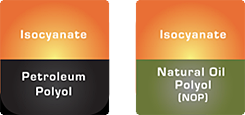They say that necessity is the mother of invention. We have been talking about sustainability in recent posts. So are there any companies that have embraced this?
Here in Southern California, surfing is a big activity. There are multiple surfboard makers. In order to keep surfboards light, but strong, foam cores are used. Clark Foams was the dominant supplier in the polyurethane surfboard blank business for 45 years. Clark Foams suddenly shut their doors in December 2005 due to EPA and OSHA issues regarding the toxic chemicals used to make polyurethane foam. Edward “Ned” McMahon, an avid surfboard “shaper” faced with the sudden elimination of a key raw material saw an opportunity. He founded Malama Composites and dedicated his company to clean chemistry.
Traditional Polyurethane Foams
Polyurethane (PU) foams are produced by the reaction of isocyanates, and hydroxyl compounds (polyols). The high reactivity of isocyanates, knowledge of their catalytic reaction, and the addition of various additives enable the formulation of PU foams with a wide range of structural and performance characteristics. These properties can range from soft but very tough elastomers to very hard, abrasion-resistant materials. PU can be rigid or flexible, and can take the form of fiber for clothing, rubber for shoes or tires, protective coatings for wood or metal, rigid structural panels, or flexible foams used in mattresses and cushioning.
Traditionally, PU foams utilize toluene diisocyanates (TDI) for the A-side of the formulation. This petrochemical is a volatile organic compound with serious health risks. Repeated exposure to TDI in the course of PU foam production has been known to cause respiratory ailments and is a suspected carcinogen. The traditional B-side polyols are derived from oil or natural gas, which are non-renewable resources and contributors to green house gas emissions. Production of these foams release volatile organic compounds into the atmosphere. The final products are difficult to reuse or recycle.
AinaCore™ Bio-Foams
 Malama’s bio-foams compete directly with petrochemical-based rigid PU foams. Their products utilize stable, far less toxic methylene diphenyl diisocyanates (MDI) for the A-side, and polyols derived from plant-based renewable sources such as soy, castor, jatropha or algae for the B-side. The resulting products are dimensionally stable, do not off-gas VOC’s, and can be easily reused or recycled.
Malama’s bio-foams compete directly with petrochemical-based rigid PU foams. Their products utilize stable, far less toxic methylene diphenyl diisocyanates (MDI) for the A-side, and polyols derived from plant-based renewable sources such as soy, castor, jatropha or algae for the B-side. The resulting products are dimensionally stable, do not off-gas VOC’s, and can be easily reused or recycled.
Malama produces foams ranging from two to eight pounds per cubic foot in density. They are available in 4’ x 8’ sheet stock, from ½” to 12” thick, and can be cut to size per customer specification, or scored for curved applications. AinaCore™ exhibits very tight, uniform cellular structure, which enables manufacturers to cut, shape and surface our material using standard manufacturing equipment.
For more information, visit www.malamacomposites.com to read how one company is on a journey to improve our environment using Green Chemistry.


Good Idea and your information are really important to us.
Keep sharing more Information!
Thank You!
Thank you, it was really helpful! 🙂